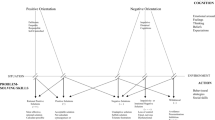Abstract
The purpose of the present study was to examine the psychometric properties of the Social Problem-Solving Inventory-Revised Short-Form (SPSI-R:SF), a 25-item self-report measure of real life social problem-solving ability. A sample of 219 Australian university students aged 16–25 years participated in the study. The reliability of the SPSI-R:SF scales was adequate to excellent. Evidence was demonstrated for convergent validity and divergent validity. Confirmatory factor analysis results were in line with past research and suggested good model fit. In addition, discriminant function analysis revealed that the SPSI-R:SF was able to significantly discriminate low and high levels of depressive symptomatology. Collectively, results suggest that the SPSI-R:SF represents a reliable and valid instrument for efficient assessment of social problem-solving ability in young Australian adults. Limitations and future research are also discussed.

Similar content being viewed by others
References
Anderson, J. C., & Gerbing, D. W. (1984). The effect of sampling error on convergence, improper solutions, and goodness-of-fit indices for maximum likelihood confirmatory factor analysis. Psychometrika, 49, 155–173. doi:10.1007/BF02294170.
Bearden, W. O., Sharma, S., & Teel, J. E. (1982). Sample size effects on chi-square and other statistics used in evaluating causal models. JMR, Journal of Marketing Research, 19, 425–430. doi:10.2307/3151716.
Beck, A. T., Steer, R. A., & Garbin, M. G. (1988). Psychometric properties of the Beck depression inventory: Twenty-five years of evaluation. Clinical Psychology Review, 8(1), 77–100. doi:10.1016/0272-7358(88)90050-5.
Beck, A. T., Ward, C. H., Mendelson, M., Mock, J., & Erbaugh, J. (1961). An inventory for measuring depression. Archives of General Psychiatry, 5, 462–467.
Bentler, P. M., & Wu, E. J. C. (1995). EQS for windows user’s guide. Encino, CA: Multivariate Software, Inc.
Cheng, S. K. (2001). Life stress, problem solving, perfectionism, and depressive symptoms in Chinese. Cognitive Therapy and Research, 25, 303–310. doi:10.1023/A:1010788513083.
D’Zurilla, T. J., & Goldfried, M. R. (1971). Problem solving and behavior modification. Journal of Abnormal Psychology, 78(1), 107–126. doi:10.1037/h0031360.
D’Zurilla, T. J., & Nezu, A. M. (1990). Development and preliminary evaluation of the social problem-solving inventory (SPSI), psychological assessment. Journal of Consulting and Clinical Psychology, 2, 156–163.
D’Zurilla, T. J., & Nezu, A. M. (2007). Problem-solving therapy: A positive approach to clinical intervention (3rd ed.). New York: Springer Publishing Co.
D’Zurilla, T. J., Nezu, A. M., & Maydeu-Olivares, A. (2002). Social problem-solving inventory-revised (SPSI-R): Technical manual. North Tonawanda, NY: Multi-Health Systems, Inc.
Frye, A. A., & Goodman, S. H. (2000). Which social problem-solving components buffer depression in adolescent girls? Cognitive Therapy and Research, 24, 637–650. doi:10.1023/A:1005583210589.
Heppner, P. P. (1988). The problem solving inventory. Palo Alto, CA: Consulting Psychologist Press.
Heppner, P. P., & Anderson, W. P. (1985). The relationship between problem-solving self-appraisal and psychological adjustment. Cognitive Therapy and Research, 9, 415–427. doi:10.1007/BF01173090.
Heppner, P. P., & Petersen, C. H. (1982). The development and implications of a personal problem-solving inventory. Journal of Counseling Psychology, 29, 65–75.
Hu, L., & Bentler, P. M. (1999). Cut-off criteria for fit indexes in covariance structure analysis: Conventional criteria versus new alternatives. Structural Equation Modeling, 6, 1–55.
Kline, R. B. (1998). Principles and practice of structural equation modeling. New York: Guilford Press.
Marsh, H. W., & Hocevar, D. (1985). Application of confirmatory factor analysis to the study of self-concept: First-and higher order factor models and their invariance across groups. Psychological Bulletin, 97, 562–582. doi:10.1037/0033-2909.97.3.562.
Maydeu-Olivares, A., & D’Zurilla, T. J. (1996). A factor-analytic study of the social problem-solving inventory: An integration of theory and data. Cognitive Therapy and Research, 20(2), 115–133. doi:10.1007/BF02228030.
Miner, R. C., & Dowd, E. T. (1996). An empirical test of the problem solving model of depression and its application to the prediction of anxiety and anger. Counselling Psychology Quarterly, 9, 163–176. doi:10.1080/09515079608256361.
Nezu, A. M. (1985). Differences in psychological distress between effective and ineffective problem solvers. Journal of Counseling Psychology, 32, 135–138. doi:10.1037/0022-0167.32.1.135.
Nezu, A. M. (2004). Problem solving and behavior therapy revisited. Behavior Therapy, 35, 1–33. doi:10.1016/S0005-7894(04)80002-9.
Nunnally, J. C. (1978). Psychometric theory. New York: McGraw-Hill Book Company.
Orbach, I., Rosenheim, E., & Hary, E. (1987). Some aspects of cognitive functioning in suicidal children. Journal of the American Academy of Child and Adolescent Psychiatry, 26, 181–185. doi:10.1097/00004583-198703000-00010.
Priester, M. J., & Clum, G. A. (1993). Perceived problem-solving ability as a predictor of depression, hopelessness, and suicide ideation in a college population. Journal of Counseling Psychology, 40, 79–85. doi:10.1037/0022-0167.40.1.79.
Sofronoff, K., Dalgliesh, L., & Kosky, R. (2005). Out of options: A cognitive model of adolescent suicide and risk-taking. New York: Cambridge University Press.
Spence, S., Sheffield, J., & Donovan, C. (2002). Problem-solving orientation and attributional style: Moderators of the impact of negative life events of the development of depressive symptoms in adolescence? Journal of Clinical Child and Adolescent Psychology, 31(2), 219–229.
Weston, R., Jr., & Gore, P. A., Jr. (2006). A brief guide to structural equation modeling. The Counseling Psychologist, 34(5), 719–751. doi:10.1177/0011000006286345.
Yoman, J., & Edelstein, B. A. (1993). Relationship between solution effectiveness ratings and actual solution impact in social problem solving. Behavior Therapy, 24, 409–430. doi:10.1016/S0005-7894(05)80214-X.
Author information
Authors and Affiliations
Corresponding author
Rights and permissions
About this article
Cite this article
Hawkins, D., Sofronoff, K. & Sheffield, J. Psychometric Properties of the Social Problem Solving Inventory-Revised Short-Form: Is the Short Form a Valid and Reliable Measure for Young Adults?. Cogn Ther Res 33, 462–470 (2009). https://doi.org/10.1007/s10608-008-9209-7
Received:
Accepted:
Published:
Issue Date:
DOI: https://doi.org/10.1007/s10608-008-9209-7




